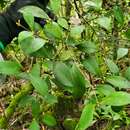zh-TW
在導航的名稱


Eugenia palumbis (Chamorro: agatelang[1]) is a shrub in the family Myrtaceae endemic to the Mariana Islands, including Guam and the Commonwealth of the Northern Mariana Islands.[2][3][4]
Eugenia palumbis is a bush or small tree 5 to 15 feet tall.[5][6][7]
Stems and leaves are smooth, except for the younger branchlets and calyces. Branches and twigs are thin and brown.
Leaf petioles are only 3 mm or less. Leaves are somewhat coriaceous and dark green but younger leaves are membranous and reddish or pale green. The underside is punctate with small scattered glands. Leaves are nearly symmetrical, elliptic or ovate-elliptic, 3.5 to 5.5 cm long. The base forms an acute angle, and the apex is obtuse. Leaf margins are slightly recurved. Leaves have about 6 slender and obscure lateral nerves per side, which form subtle loose anastomoses.
Flowers are white. Merrill found the species distinctive because of its "small, axillary, solitary, very shortly pedicelled flowers" not larger than 1 cm in diameter.[1] Pedicelled are stout at about 2 mm diameter. The calyx is papery, glandular, greenish, and funnel-shaped, 3 to 3.5 mm long and 3 mm wide, consisting of 4 oval-shaped lobes.[8] Stamens are indefinite. Filaments are 2 to 3 mm long; anthers 0.7 mm long. Petals are not seen.[1]
Fruits are round, about 6 to 8 mm diameter, orange initially and ripening to bright red.[9][10][11] Fruits are edible and sweet tasting.[12]
The species has been observed on Guam,[13] Rota,[14] Aguiguan,[15] Tinian,[16] Saipan,[17] and Pagan.[18]
It is found on limestone cliffs,[19] sloping limestone terraces, sandy flats, and in primary and secondary limestone forests.[5][20] On Pagan it has been observed growing from volcanic rocks.[21] It can be found at least as high as 500 feet above sea level.[22]
As of 2023, the species has not been assessed by the IUCN.[23]
The species was first known to be collected in 1906 by German immigrant Hermann L. Costenoble, who would later become Guam's chief forester.[24] In 1914, American botanist Elmer D. Merrill used Costenoble's preserved specimens to name and describe Eugenia palumbis as a new species in the Philippine Journal of Science, as well as recording the indigenous name, agatelang. Merrill named the species after the elderly Padre José Palomo, the first CHamorro Catholic priest who, Merrill acknowledged, had helped the new American administration learn about the island, including providing some botanical material.[1][25]
Fosberg spelled the CHamorro name agatelong.[26]
The wood is hard and very flexible, and has been used to make axe handles, and booms for ox-carts.[27]
Eugenia palumbis (Chamorro: agatelang) is a shrub in the family Myrtaceae endemic to the Mariana Islands, including Guam and the Commonwealth of the Northern Mariana Islands.
Eugenia palumbis adalah spesies tumbuhan yang tergolong ke dalam famili Myrtaceae. Spesies ini juga merupakan bagian dari ordo Myrtales. Spesies Eugenia palumbis sendiri merupakan bagian dari genus Eugenia.[1] Nama ilmiah dari spesies ini pertama kali diterbitkan oleh Merr..
Eugenia palumbis adalah spesies tumbuhan yang tergolong ke dalam famili Myrtaceae. Spesies ini juga merupakan bagian dari ordo Myrtales. Spesies Eugenia palumbis sendiri merupakan bagian dari genus Eugenia. Nama ilmiah dari spesies ini pertama kali diterbitkan oleh Merr..
Eugenia palumbis là một loài thực vật có hoa trong Họ Đào kim nương. Loài này được Merr. mô tả khoa học đầu tiên năm 1914.[1]
Eugenia palumbis là một loài thực vật có hoa trong Họ Đào kim nương. Loài này được Merr. mô tả khoa học đầu tiên năm 1914.